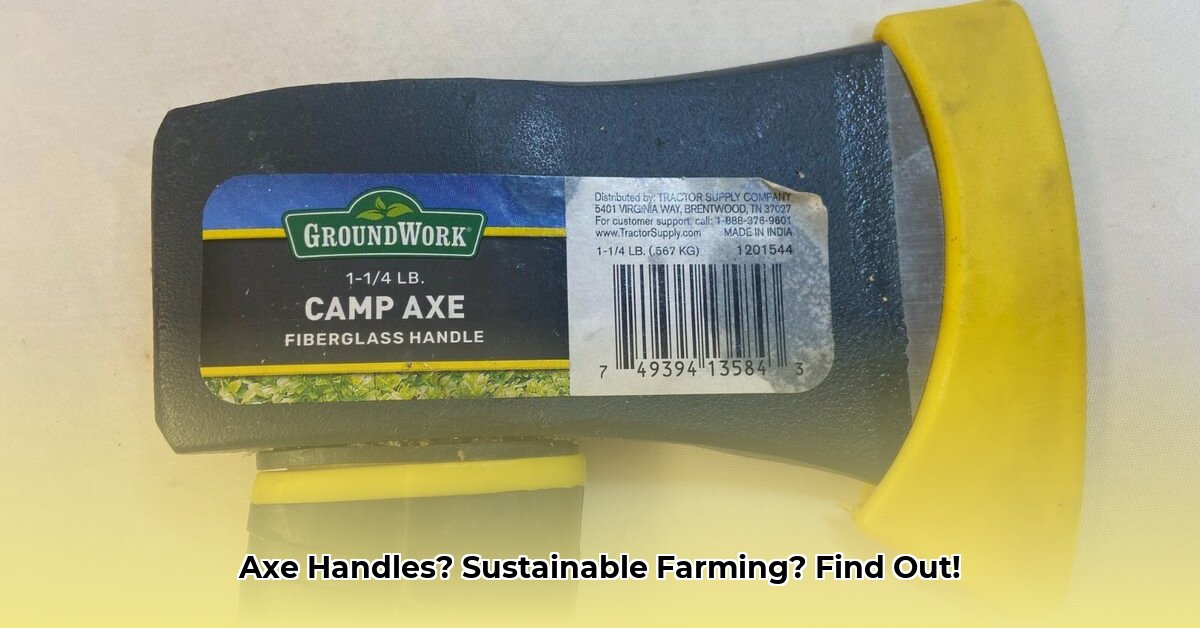
Sustainable farming demands responsible practices, and sometimes that means embracing traditional tools like the axe. This guide focuses on selecting and using Tractor Supply axe handles effectively and sustainably, covering everything from choosing the right tool to using it safely and considering eco-friendly alternatives. We'll arm you with the knowledge to contribute to a greener future, one well-placed swing at a time. For more information on Tractor Supply tools, check out this helpful guide.
Selecting Your Perfect Tractor Supply Axe Handle
Choosing the right axe handle is about more than just picking one off the shelf. Several key factors significantly impact its performance and longevity, directly influencing your efficiency and sustainability efforts. A poorly chosen axe can lead to wasted time, effort, and even injury.
Handle Material: Strength and Sustainability
The handle material plays a crucial role in the axe's durability and lifespan. Hickory and ash are excellent choices due to their strength, shock absorption, and resistance to splitting—qualities vital for efficient and safe use. These woods can last for years with proper care, reducing the need for frequent replacements and minimizing waste. However, ensuring the wood comes from sustainably managed forests is equally important; look for certifications indicating responsible sourcing. Isn't it interesting how even a simple choice like axe handle material can have far-reaching environmental consequences?
Size, Weight, and Grip: Ergonomics and Efficiency
Axe size and weight influence its suitability for different tasks. A heavier axe is better for felling larger trees, requiring more power but potentially causing greater strain. Conversely, a lighter axe is ideal for smaller tasks, like pruning or limbing, ensuring better maneuverability and reducing fatigue. The grip is equally crucial; a comfortable, well-designed grip can prevent hand fatigue, blisters, and potential injury during prolonged use. A proper grip is essential for safe and efficient operation, regardless of the task at hand.
Axe Head: Quality and Longevity
The axe head's quality directly affects its performance and longevity. A high-quality, well-balanced head will stay sharp longer, reducing the frequency of sharpening—and sharpening is an essential part of axe maintenance. Regular sharpening reduces the force required for each swing, increasing safety and efficiency. A dull axe is dangerous, requiring more forceful swings which increases the risk of injury and promotes inefficient work. Tractor Supply sometimes sells axe heads and handles separately, so ensure a secure and well-fitted union before committing to a purchase. A loose head is incredibly dangerous.
Safe and Efficient Axe Use: A Step-by-Step Guide
Safety is paramount when using any tool, especially an axe. Before you begin, always wear appropriate safety gear: eye protection, sturdy gloves, and strong work boots with good ankle support. Here's a step-by-step guide to felling trees safely and responsibly:
Assess the Tree and Surroundings: Before lifting the axe, carefully examine the tree—inspect for dead branches and assess its lean. Plan your escape route before you begin cutting. A clear escape path is crucial should the tree fall unexpectedly.
Making the Notch: Carefully cut a notch on the side where you want the tree to fall. This guides the tree's fall and helps control its direction, minimizing the risk of unpredictable movement.
The Back Cut: Make your back cut several inches above the notch, leaving a hinge of wood. This hinge is crucial for controlling the tree's fall. Don't cut completely through; leaving that hinge ensures a controlled felling process.
The Felling: Use wedges if needed, particularly with larger trees or those leaning in an unfavorable direction. Never stand directly behind the falling tree. This is the most important safety rule to remember.
Limbing and Bucking: Carefully remove branches (limbing) and cut the tree into manageable sections (bucking), maintaining a safe distance at all times.
Maintenance: Regular maintenance is key to maximizing axe lifespan and ensuring safety. Sharpen your axe frequently as a sharp axe is safer and more efficient. Oil the head after each use to prevent rust, and store it properly to protect it from damage and ensure its readiness for the next use.
Exploring Alternatives: Beyond the Axe
While axes are valuable tools, several alternatives offer different advantages depending on the task and scale of the operation.
Handsaws: Handsaws are an excellent ecologically sound alternative for many applications. They require more effort but result in greater precision and quieter operation, especially suitable for smaller jobs or in noise-sensitive areas.
Chainsaws: Chainsaws offer speed and power, crucial for larger-scale operations. However, their fuel consumption, noise pollution, and potential for damage necessitate careful consideration of their environmental impact--consider using low-emission models and employing safe operating procedures.
Mechanized Logging Equipment: This option provides exceptional efficiency for large-scale operations, but the substantial upfront investment should be weighed against its environmental impact and potential for soil compaction. Careful assessment of its efficiency against the potential ecological impact is essential.
The ideal tool should be selected based on the specific task, considering factors like the scale of the project, environmental sensitivity, and the resources available.
Sustainable Sourcing and Responsible Disposal: Completing the Cycle
Sustainable forestry practices extend beyond the selection process to encompass the sourcing and eventual disposal of the axe. Support manufacturers committed to responsible wood sourcing and sustainable forestry. Look for certifications, like the Forest Stewardship Council (FSC) standard, that indicate environmentally responsible practices.
Proper disposal is equally important. Avoid simply discarding the axe; explore recycling options for the metal head and responsible disposal of the wooden handle, minimizing landfill waste. Completing the cycle of sustainability is not merely responsible, but crucial in building a greener future.
Conclusion: A Sustainable Approach to Farming
Sustainable practices require mindful choices at every step, from tool selection to disposal. By carefully selecting your Tractor Supply axe handle, employing safe techniques, and considering environmentally sound alternatives, you can make a positive contribution to the earth’s health. Responsible farming isn't just about what you grow, but about how you grow it while protecting the environment.